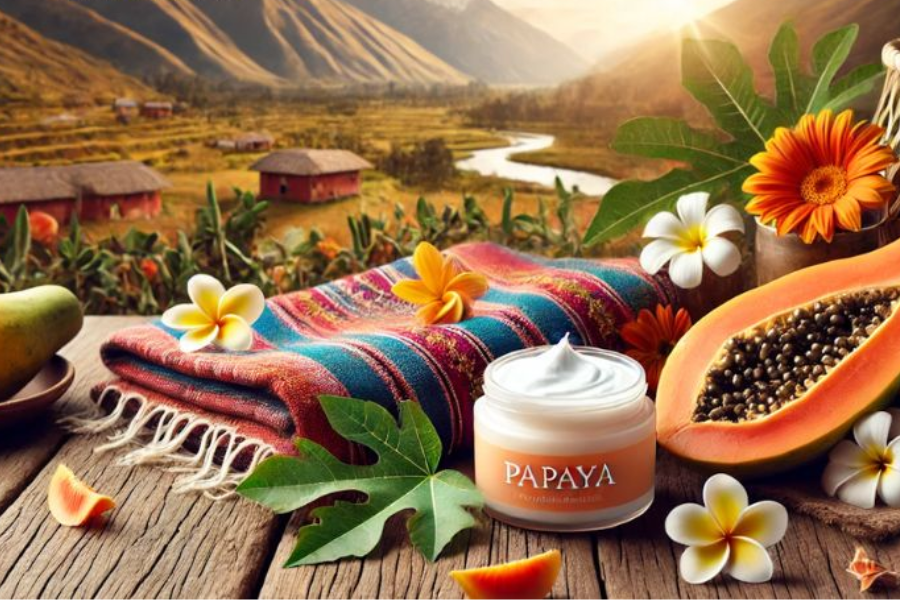Crema Hidratante De Papaya EN Peru Tesis Doctoral: Unlocking the Secrets of Natural Skincare
Introduction
In the world of skincare, the quest for effective, natural solutions is more important than ever. Papaya, a tropical fruit celebrated for its rich nutritional profile, stands out as a key ingredient in this pursuit. In Peru, a country renowned for its biodiversity and rich cultural heritage, the use of natural ingredients in beauty products is a long-standing tradition. The exploration of papaya as a foundational element in moisturizers has sparked interest in academia, particularly through the lens of a doctoral thesis focused on developing a “Crema Hidratante De Papaya EN Peru Tesis Doctoral.”
This article delves into the intricacies of such a thesis, shedding light on its significance and how it contributes to the evolving field of natural skincare.
The Growing Interest in Natural Skincare
As consumers become increasingly conscious of the ingredients in their skincare products, there is a notable shift towards natural and organic formulations. This trend is particularly evident in Peru, where the local culture embraces the use of natural resources for health and beauty. Papaya, with its impressive array of vitamins and enzymes, has emerged as a favored ingredient for moisturizing creams. A doctoral thesis exploring a “Crema Hidratante De Papaya EN Peru Tesis Doctoral” would likely examine the ways these elements work synergistically to hydrate and rejuvenate the skin, positioning papaya as a viable alternative to synthetic ingredients that often dominate the market.
Understanding the Nutritional Profile of Papaya
Crema Hidratante De Papaya EN Peru Tesis Doctoral
Papaya is not just a delicious fruit; it is also packed with essential nutrients that make it a standout candidate for skincare formulations. Key components include:
- Vitamin A: Known for its role in repairing skin damage, vitamin A helps maintain a healthy and radiant complexion.
- Vitamin C: This potent antioxidant plays a crucial role in protecting the skin from environmental damage caused by free radicals, promoting a youthful appearance.
- Vitamin E: Providing deep hydration, vitamin E helps combat signs of aging and supports overall skin health.
Additionally, the enzyme papain found in papaya serves as a natural exfoliant, gently removing dead skin cells to reveal a brighter and smoother complexion. The focus of a doctoral thesis on a papaya moisturizing cream would involve analyzing how these nutrients can be effectively harnessed in skincare formulations.
The Process of Developing a Papaya Moisturizing Cream
Creating a “Crema Hidratante De Papaya EN Peru Tesis Doctoral” involves multiple stages of research and development, beginning with a comprehensive literature review. This foundational step is crucial to understand the existing knowledge regarding the benefits of papaya for skin health. By studying previous research on the chemical properties of papaya and its interactions with the skin, researchers can lay the groundwork for further investigation.
Formulation Phase
Once the literature review is complete, the next step is to formulate the moisturizing cream. This phase involves experimenting with different combinations of papaya extract and other natural ingredients to identify the optimal blend. Researchers will need to conduct careful experiments to determine the best concentration of papaya and complementary components to achieve desired skincare results.
Testing and Analyzing the Efficacy of the Cream
After formulating the cream, the next phase involves rigorous testing to evaluate its effectiveness. Clinical trials can be conducted where participants use the cream over a specified period, allowing researchers to monitor changes in their skin condition. Key metrics for assessment might include:
- Hydration levels
- Skin elasticity
- Reduction in fine lines
- Overall skin texture
The data collected from these trials will provide valuable insights into the cream’s effectiveness and validate its potential as a natural skincare option.
Cultural and Environmental Considerations
In the context of developing a “Crema Hidratante De Papaya EN Peru Tesis Doctoral,” it is essential to consider the cultural and environmental factors that influence skin care practices in Peru. The diverse climate and geography across the country mean that different regions have varying skincare needs.
For instance, the humid climate of the Amazon region may necessitate a lighter, more breathable moisturizer, while the dry, arid areas might require a richer, more hydrating formula. Furthermore, the cultural significance of utilizing natural ingredients, particularly those sourced locally, is a vital aspect of the research that cannot be overlooked.
Challenges in Formulating Papaya-Based Cream
While papaya holds numerous benefits for the skin, developing a moisturizing cream with this ingredient presents challenges. One primary concern is ensuring the stability of the cream. Natural ingredients often have a shorter shelf life than synthetic alternatives, which can lead to degradation over time. Thus, preserving the integrity of the papaya extract without the use of synthetic preservatives is critical.
Another significant challenge is the potential for allergic reactions, as some individuals may be sensitive to specific compounds found in papaya. A comprehensive approach must be taken in the thesis to address these challenges, including extensive testing and the development of solutions that ensure the cream’s safety and efficacy.
The Role of Academic Research in Skincare Innovation
The exploration of a “Crema Hidratante De Papaya EN Peru Tesis Doctoral” represents a vital contribution to the natural skincare industry. Academic research plays an essential role in substantiating the effectiveness of natural ingredients and pioneering the development of new products that cater to consumer needs. By conducting thorough research and rigorous testing, a doctoral thesis on this topic can advance our understanding of how natural ingredients, such as papaya, can be utilized to create effective skincare solutions.
This research may also pave the way for further studies and innovations, leading to new products that meet the rising consumer demand for natural and organic skincare options.
Market Potential and Consumer Acceptance
The market potential for a papaya-based moisturizing cream in Peru is substantial, especially given the growing interest in natural products among consumers. A doctoral thesis examining a “Crema Hidratante De Papaya EN Peru Tesis Doctoral” would likely include a market analysis assessing consumer attitudes towards papaya in skincare and the demand for such products.
This analysis could involve conducting surveys, focus groups, and interviews with potential consumers to understand their perceptions of papaya as an ingredient and their willingness to purchase a papaya-based moisturizer. The insights gained from this analysis would be invaluable in determining the commercial viability of the product and informing its development and marketing strategies.
The Impact on the Peruvian Skincare Industry
If the research conducted in a “Crema Hidratante De Papaya EN Peru Tesis Doctoral” thesis proves successful, it could have far-reaching implications for the Peruvian skincare industry. By providing scientific evidence of papaya’s benefits, the thesis could inspire local companies to develop and market papaya-based skincare products. This would not only create demand for papaya but also support local farmers and promote the use of natural ingredients sourced from Peru.
Additionally, this research could attract international interest, potentially leading to export opportunities for Peruvian skincare products and further enhancing the country’s reputation in the global beauty market.
Sustainability and Ethical Considerations
When developing a “Crema Hidratante De Papaya EN Peru Tesis Doctoral,” sustainability and ethical considerations are paramount. The sourcing of papaya must be conducted in a manner that is environmentally sustainable and supportive of local farmers’ livelihoods.
The thesis might explore sustainable farming practices that enhance the quality of the papaya used in the cream while also examining the broader implications of product development. Ensuring that the final product is accessible and affordable to a wide range of consumers is crucial, reflecting a commitment to social responsibility alongside innovation.
FAQs:
1. What is “Crema Hidratante De Papaya EN Peru Tesis Doctoral”?
“Crema Hidratante De Papaya EN Peru Tesis Doctoral” is a moisturizing cream formulated using papaya as a key ingredient. It harnesses the natural nutrients and enzymes found in papaya to hydrate and rejuvenate the skin.
2. Why is papaya used in skincare products?
Papaya is rich in vitamins A, C, and E, as well as the enzyme papain, which makes it an effective natural ingredient for skincare. These components contribute to skin repair, protection from environmental damage, and gentle exfoliation.
3. What are the benefits of using papaya in moisturizers?
Papaya offers several skincare benefits, including improved hydration, enhanced skin elasticity, reduction of fine lines, and overall better skin texture due to its nourishing properties.
4. How is the “Crema Hidratante De Papaya EN Peru Tesis Doctoral” developed?
The development process includes a literature review, formulation phase, and extensive testing. Researchers analyze the optimal concentration of papaya extract and other natural ingredients to create an effective moisturizer.
5. What challenges are faced in formulating papaya-based creams?
Key challenges include ensuring the stability of natural ingredients, which may have shorter shelf lives than synthetic ones, and addressing potential allergic reactions in sensitive individuals.
Conclusion
The exploration of a “Crema Hidratante De Papaya EN Peru Tesis Doctoral” through a doctoral thesis represents a significant step forward in the realm of natural skincare. By highlighting the nutritional benefits of papaya and its potential as an effective moisturizer, this research underscores the value of natural ingredients in skincare formulations.
The insights gleaned from such a thesis not only enhance our understanding of papaya’s properties but also contribute to the ongoing evolution of the skincare industry in Peru. As the demand for natural and organic products continues to grow, the research may well serve as a catalyst for innovation and economic growth, benefiting both consumers and local communities.





